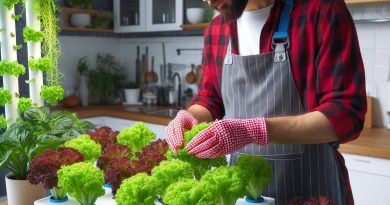Compact Composting: Tips for Tiny Areas
Last Updated on March 2, 2024
Introduction
Composting is usually associated with large gardens and outdoor spaces, but it can also be done in small living areas.
Compact composting is the solution for those who want to reduce waste, benefit the environment, and have limited space.
Even in tiny living spaces, composting plays a significant role in sustainability.
In small apartments or urban environments, composting may seem challenging.
However, it is essential to recognize that composting can be beneficial even in these limited areas.
By composting, you can divert kitchen scraps and yard waste from landfills and create nutrient-rich soil for plants.
This blog post aims to provide practical tips for successful compact composting in tiny areas.
From choosing the right composting method to managing odor and moisture, this guide will cover everything you need to know.
It will help you make the most out of your limited space and contribute to a greener and more sustainable lifestyle.
Whether you have a small balcony, a tiny courtyard, or even just a countertop, there are composting options available for you.
You don’t need a big backyard to practice composting.
By understanding the methods and techniques suitable for compact composting, you can turn your small living space into a thriving environment for composting.
Understanding compact composting
Define compact composting
Compact composting refers to the practice of composting in small areas using limited space and resources.
Benefits of compact composting
- Space-saving: Compact composting allows individuals with limited outdoor space to still engage in composting activities.
- Nutrient-rich soil: The compost produced through compact composting is rich in nutrients and can be used to improve soil quality in small gardens or containers.
- Reduced waste: By composting organic waste in compact containers, individuals can divert waste from landfills and contribute to a more sustainable environment.
- Cost-effective: Compact composting eliminates the need for purchasing commercial fertilizers, saving money in the long run.
Examples of suitable composting containers for small areas
- Worm composting bins: These containers are perfect for small areas, such as balconies or apartments, as they can be kept indoors.
- Tumbling composters: These compact containers can be easily rotated to speed up the composting process and are ideal for small yards.
- Plastic bins with tight-fitting lids: These containers are affordable and easy to find, making them a practical choice for compact composting.
- Compost bags: Compost bags are portable, making them suitable for individuals who frequently move or have limited outdoor space.
Read: Space-Saving Farm: Hydroponic Techniques
Tips for successful compact composting
Choose the right location
- Consider sunlight: Place the composting container in a location that receives adequate sunlight to promote decomposition.
- Accessibility: Ensure the chosen location is easily accessible for adding kitchen scraps and turning the compost.
Start with a balanced mix of organic materials
- Carbon-rich materials: Add dry leaves, shredded paper, or cardboard to provide the necessary carbon content in the compost.
- Nitrogen-rich materials: Include kitchen scraps, grass clippings, or coffee grounds to provide the required nitrogen for composting.
Maintain proper moisture levels
- Regularly monitor moisture: Keep the compost moist, but not too wet, by watering or covering it during rainy periods.
- Sprinkle water if necessary: If the compost appears dry, add water to maintain the right moisture level for decomposition.
Turn the compost regularly
- Aerating the compost: Turning the compost helps introduce oxygen and speeds up the decomposition process.
- Frequency of turning: Aim to turn the compost every few weeks or when it becomes compacted or smells unpleasant.
Monitor and adjust the composting process
- Temperature: Use a compost thermometer to ensure the internal temperature remains between 110-160°F (43-71°C) for efficient decomposition.
- Adjust the mix: If the compost is too wet, add dry carbon-rich materials, or if it’s too dry, add moisture-rich materials.
Harvest the compost
- Recognize signs of maturity: The compost is ready to be harvested when it has a dark brown color, an earthy smell, and a crumbly texture.
- Separate finished compost: Remove the fully decomposed compost from the container and set it aside for use in gardens or potted plants.
Utilize the compost
- Soil amendment: Mix compost into garden soil or potting mixes to improve soil structure, fertility, and water retention.
- Mulching: Spread a layer of compost on top of the soil to suppress weed growth, conserve moisture, and regulate temperature.
Compact composting allows individuals in tiny areas to actively contribute to organic waste reduction while producing nutrient-rich compost for their plants.
With the right containers, proper techniques, and regular care, compact composting can be successfully accomplished in any small space.
Read: Urban Oasis: Aquaponic Gardening Basics
Selecting the right materials
Importance of choosing the right materials for composting in small spaces
When it comes to compact composting, selecting the right materials is of utmost importance.
Not all organic materials are suitable for small composting setups.
It is crucial to choose materials that decompose quickly and efficiently, without taking up too much space.
Suitable organic materials for compact composting
There are numerous organic materials that are ideal for compact composting.
These include kitchen scraps, such as fruit and vegetable peels, coffee grounds, and eggshells.
Additionally, leaves, grass clippings, and small branches can also be used.
Materials to avoid in small composting setups
While there are many suitable materials, there are also some that should be avoided in small composting setups.
These include meat, dairy products, oils, and fats.
These materials tend to attract pests and can create unpleasant odors in compact spaces.
Tips for sourcing materials in small quantities
Sourcing materials in small quantities might seem challenging, but there are a few tips to make it easier.
Starting a community composting program
Consider starting a community composting program and work together with neighbors or friends who also have limited space.
Additionally, reach out to local grocery stores or restaurants to collect their food waste for composting.
Create a composting cooperative
One option is to create a composting cooperative, where each member contributes organic materials and collectively manages the composting process.
This way, everyone can benefit from the resulting compost.
Source materials in small quantities
Another way to source materials in small quantities is through composting workshops or seminars.
Local organizations or environmental groups often organize these events, providing participants with the knowledge and materials needed to start compact composting.
It is also essential to utilize the space efficiently.
Stackable composting bins or worm composting systems can be used to maximize the available area.
These systems allow for layering of materials, creating a more efficient composting process in small spaces.
Additionally, consider using shredded paper or cardboard as a carbon-rich ingredient in the compost.
These materials are readily available at home and can be used in small quantities to balance the nitrogen-rich kitchen scraps.
Furthermore, it is important to regularly turn and aerate the compost to promote decomposition.
In compact setups, this can be a bit tricky, but using a small compost tumbler or a pitchfork can make the process easier.
Generally, selecting the right materials for compact composting is crucial for successful composting in small areas.
Choosing suitable organic materials and avoiding certain items will ensure a productive and odor-free composting process.
By implementing tips for sourcing materials in small quantities and utilizing space efficiently, compact composting can be achieved in even the tiniest areas.
So, start composting today and turn your small space into a thriving ecosystem of nutrient-rich soil!
Read: From Water to Table: Hydroponic Growing

Managing composting processes in tiny areas
The significance of proper management in compact composting
Proper management is crucial for compact composting to ensure efficient decomposition and odor control.
- Regular monitoring helps identify any issues and adjust the composting process accordingly.
- Maintaining the right temperature range allows for the breakdown of materials and minimizes pathogens and weed seeds.
- Adequate management promotes faster decomposition, resulting in nutrient-rich compost for gardening purposes.
The importance of balancing carbon-rich (browns) and nitrogen-rich (greens) materials
Balancing brown and green materials is essential to create a healthy composting environment.
- Carbon-rich materials, such as dry leaves and straw, provide energy for microbes and aid in aeration.
- Nitrogen-rich materials, like grass clippings and kitchen scraps, provide necessary nutrients for microbial growth.
- Maintaining the right carbon-to-nitrogen ratio (C:N) of around 30:1 helps prevent odor issues and ensures effective composting.
Tips for managing moisture levels in small composting setups
Managing moisture is crucial to maintain the right environment for composting.
- Check the moisture content regularly by squeezing a handful of compost. It should be moist but not dripping.
- If the compost is too dry, add water in small increments, mixing it thoroughly to avoid waterlogging.
- If the compost is too wet, add dry brown materials to absorb excess moisture and improve aeration.
The role of aeration and how to ensure proper airflow in compact composting
Aeration is vital for composting, as it provides oxygen for aerobic microorganisms and prevents anaerobic conditions.
- Turn or mix the compost regularly using a pitchfork or shovel to improve airflow and prevent compaction.
- Incorporate bulky materials like twigs or straw to create air pockets within the compost pile.
- Consider using compost aerating tools or compost tumblers to facilitate aeration in small composting setups.
By implementing proper management techniques, maintaining a balanced mix of carbon-rich and nitrogen-rich materials, monitoring moisture levels, and ensuring adequate aeration, compact composting can be successful even in tiny areas.
Read: Organic Garden Pest Identification Guide
Troubleshooting common compact composting issues
Common problems encountered in small-scale composting
- Unpleasant odor emanating from the compost bin.
- Invasion of pests like flies, ants, or rodents.
- Difficulty achieving proper decomposition and slow breakdown of organic materials.
- High moisture content leading to a slimy or wet compost pile.
- Insufficient air circulation causing a compact and anaerobic composting environment.
Tips for overcoming challenges
- Ensure a proper balance of carbon-rich (browns) and nitrogen-rich (greens) materials.
- Avoid adding meat, dairy, and oily food scraps that attract pests and create odor issues.
- Add a layer of dry leaves, shredded newspaper, or wood chips to control odor and pests.
- Regularly turn the compost pile to enhance decomposition and increase oxygen flow.
- Monitor moisture levels and adjust by adding dry materials or watering if it’s too dry.
Troubleshooting common compact composting issues
Odor
Odor can be caused by imbalances in the compost pile or improper aeration.
Here’s how to troubleshoot:
- Check the brown to green ratio – add more browns if it’s too green and vice versa.
- Turn the compost pile regularly to improve aeration and prevent anaerobic conditions.
- Avoid adding large amounts of food scraps at once – layer them with dry materials.
- Keep the compost pile slightly moist, but not excessively wet, to control odors.
- Add a compost accelerator or activator to speed up decomposition and reduce odors.
Pests
Pests can be attracted to food waste or if the compost pile is not properly maintained.
Try these solutions:
- Avoid adding meat, dairy, or oily foods that attract pests – stick to plant-based materials.
- Bury food waste under a layer of dry materials to prevent pests from accessing it.
- Regularly turn the compost pile to disrupt pest activity and discourage infestations.
- Use wire mesh or a cover to keep pests out while still allowing airflow within the compost bin.
- Avoid overwatering, as excessive moisture can also attract pests like mosquitoes.
Slow decomposition
If your compost is taking longer than expected to decompose, try these troubleshooting tips:
- Ensure a proper balance of carbon and nitrogen-rich materials for optimal decomposition.
- Shred or chop larger materials into smaller pieces to speed up the breakdown process.
- Turn the compost pile more frequently to maximize oxygen flow and enhance decomposition.
- Monitor moisture levels and adjust as needed – a well-aerated, moist pile promotes decomposition.
- Consider adding compost activators or a small amount of finished compost to accelerate the process.
By troubleshooting these common compact composting issues, you can successfully maintain a healthy and productive compost pile even in tiny areas.
Harvesting and using compost in small areas
When and how to harvest compost in small spaces
When your compost appears dark, crumbly, and earthy, it is ready to be harvested.
To harvest, start from the bottom by spreading a tarp and scoop the compost from the top layer.
Make sure to remove any large, undecomposed materials and save them for the next compost batch.
Benefits of using compost in limited gardening areas
Using compost in limited gardening areas improves soil fertility, structure, and water-holding capacity.
Compost also provides essential nutrients for plants, suppresses diseases, and increases beneficial soil organisms.
In small spaces, compost acts as a natural fertilizer, reducing the need for synthetic chemicals.
Ideas and suggestions for using mature compost effectively in tiny gardens or potting plants
- Mix compost with potting soil: Combine compost and potting soil in a 1:1 ratio for potted plants. This enriches the soil and provides a nutrient boost for healthier and more productive plants.
- Use compost as a top dressing: Spread a thin layer of compost on the soil surface around plants. This acts as a mulch, conserving moisture, reducing weeds, and slowly releasing nutrients into the soil.
- Create compost tea: Steep a handful of finished compost in a bucket of water for 24-48 hours. Strain the liquid and use it as a nutrient-rich liquid fertilizer to water plants.
- Make compost-based soil blocks: Mix compost, vermiculite, and water to create a moldable mixture. Form this mixture into small blocks, allowing it to dry. Use the blocks as seed-starting or transplanting pods.
- Establish a compost tower: Utilize vertical gardening by constructing a compost tower using wire mesh or a barrel. Fill it with alternating layers of compost and soil to grow plants, saving precious space in tiny gardens.
Additional Ideas
- Implement compost trenching: Dig a shallow trench in your garden bed and fill it with compost. Plant vegetables or flowers directly above the trench, allowing their roots to reach the compost for nourishment.
- Opt for compost-filled pots: Fill containers or pots with mature compost, leaving some space for proper drainage. This provides an ideal growth medium for plants with limited root spaces, ensuring healthier and vibrant blooms.
- Feed compost to houseplants: Mix a small amount of compost with the existing potting soil of indoor plants. The nutrient-rich compost will enhance plant growth and overall health, reducing the need for additional fertilizers.
In a nutshell, harvesting compost in small areas involves identifying its readiness, removing undecomposed materials, and saving them for future batches.
Using compost in limited gardening spaces offers numerous benefits such as improved soil fertility, disease suppression, and reduced reliance on synthetic chemicals.
Employing various techniques like mixing compost with potting soil, creating compost tea, or using compost as a top dressing allows for effective use in tiny gardens or potting plants.
These methods maximize the benefits of compost, enhancing plant growth and minimizing waste in compact composting areas.
Discover More: Pruning 101: Tips for Healthier Plants
Find Out More: Ergonomic Gardening Tools for Easier Work
Conclusion
Key points discussed in the blog post
Compact composting is achievable even for those with tiny outdoor areas or no yard at all.
As summarized in this blog post, the keys are using a small bin, focusing on food scraps, and keeping an ideal balance of greens, browns, air, and moisture.
By following a few basic guidelines, anyone can reap the rewards of enriched soil, reduced waste, and an environmentally-friendly hobby.
Reinforce the benefits of compact composting
Home composting offers many advantages over sending waste to crowded landfills.
Food scraps and yard trimmings comprise over 25% of what gets thrown out, contributing to methane emissions.
Composting this material at home eliminates these greenhouse gases.
It also nurtures healthy soil microbial life and creates a free, natural fertilizer to improve gardens of any size.
With a bit of effort, city dwellers and suburbanites alike can experience these benefits through compact composting methods.
Encouragement for readers to start composting even in small living areas
You don’t need acreage or advanced skills to begin – just enthusiasm and this handy guide.
Choose an appropriate bin and site, gather brown and green ingredients from your kitchen and community, and tend your pile attentively.
Soon you’ll see waste transformed into black gold for your plants.
Why not start small with compact composting this season?


